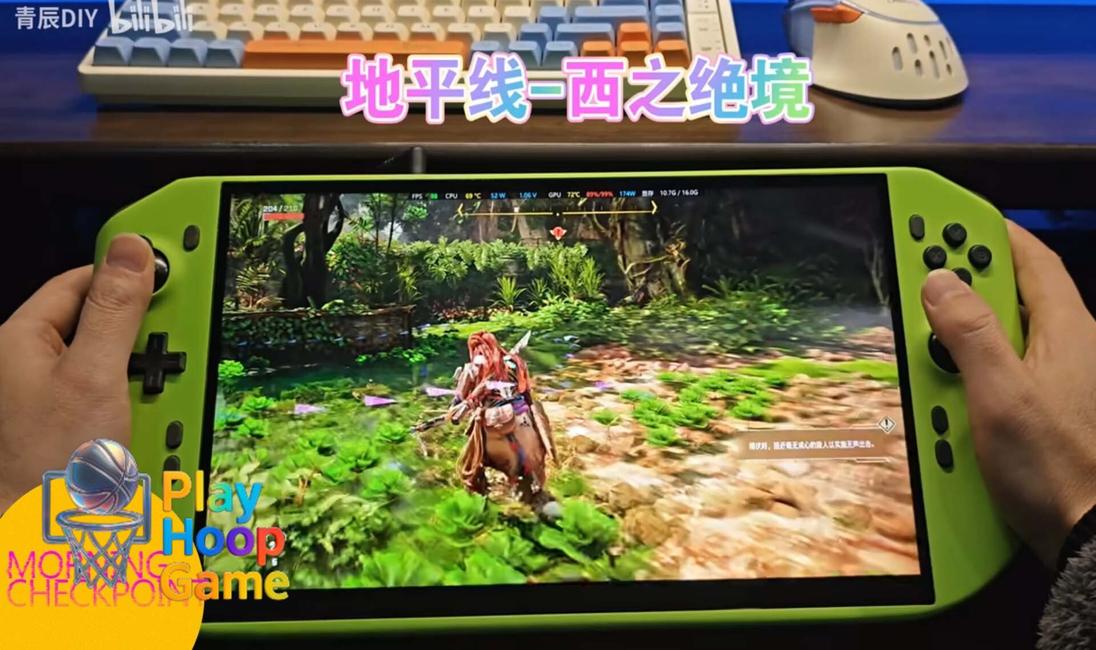I remember the first time I saw a UMPC—an Ultra-Mobile PC—back in the mid-2000s. It was a tiny little brick with a full version of Windows XP, a resistive touchscreen you had to jab with a stylus, and a processor that would probably lose a fight with a modern smart-toaster. The dream was there, though. Oh, the dream was so vividly there: real PC gaming, on the go. Not a cut-down version, not a "mobile port," but the real deal. We just... didn't have the technology.
We do now. And some people are taking that dream to its absolute, logical, and gloriously unhinged conclusion.
The Glorious Insanity of 'Too Much'
And that brings me to this... this thing. A creation that has been floating around the deepest, nerdiest corners of the internet. A handheld PC so audacious, so unapologetically massive, that it makes a Steam Deck look like a Nintendo DS Lite. It's the kind of project that doesn't ask "should we?" but screams "we can."
It's a monument to excess. It's beautiful. It's probably a terrible idea from a practical standpoint. And I am absolutely obsessed with it.
Because here's the thing. The commercial market, with devices like the ROG Ally and the Legion Go, is all about compromise. It has to be. They're balancing power, weight, battery life, and—the most boring but necessary evil—price. They're chasing the mythical "sweet spot."
But the modding community? They don't care about your sweet spot. They care about the peak.
So, What's Actually Under the Hood of this Monster?
Let me try to break down what we're actually looking at here. You see a picture of this beast and you think, "Okay, big screen, some buttons." But that's like looking at a Saturn V rocket and saying, "tall tube." The genius—and the madness—is all on the inside.
At its heart, this isn't just some repurposed laptop motherboard crammed into a 3D-printed case. No, that would be too simple. The builder, a legend in the DIY hardware scene, sourced a Framework 13 Mainboard. If you don't know Framework, they're the folks making modular, repairable laptops. This choice is brilliant because it provides a powerful, compact, and relatively efficient core based on modern AMD Ryzen APUs—the same kind of chip architecture that powers the current generation of official handhelds, just... more. A lot more.
We're talking about a Ryzen 7 7840U, a chip that sips power in a thin-and-light laptop but can absolutely scream when you let it breathe. And oh boy, does this thing let it breathe. The cooling system isn't some tiny fan and a heat pipe; it's a custom-designed array that looks like it was ripped out of a high-end gaming laptop. Because it basically was.
Then there's the screen. It's a gorgeous 8-inch, high-refresh-rate panel. The RAM is maxed out. The storage is a multi-terabyte NVMe SSD. It's not a handheld that can play PC games. It's a desktop PC that happens to be shaped (vaguely) like a handheld. The whole thing is powered by a battery that I can only assume is classified as a strategic resource by several small countries.
Why This Modder Builds The Chonkiest, Most Powerful PC Gaming Handheld Yet
You might be wondering, "But... why?" Why go to all this trouble when you can just buy a perfectly good device off the shelf? It's a fair question. And the answer gets to the very soul of the PC enthusiast community.
First, it's about pushing boundaries. It's the Everest argument: because it's there. The components exist to create something that outperforms anything on the commercial market, so someone has to do it. It’s a proof of concept that redefines the ceiling of what's possible. Every time a project like this surfaces, it subtly shifts the conversation and puts pressure on the big manufacturers. They see what the community is clamoring for, what they're willing to build themselves, and maybe—just maybe—it influences the design of the next generation of devices.
Second, it's about control. When you build it yourself, you choose everything. The screen, the sticks, the d-pad, the button feel. You're not beholden to whatever decisions a product manager in a boardroom made. You want Hall effect sticks? Done. You want an extra-clicky d-pad for fighting games? You can source it. This level of customization is the ultimate expression of the PC ethos. It's your machine, in every sense of the word.
And finally, it's a statement. It's a piece of functional art. It says that passion and ingenuity can still triumph over mass-market homogenization. It's the same spirit that leads to wild PC case mods or people building simulators in their basements. It's not just about playing the game; it's about celebrating the hardware that makes it possible. It’s a community as wild and creative as the one that resulted in a bizarre Labubu doll heist, just expressed through solder and thermal paste instead of... well, whatever that was.
The Beautiful, Impractical Reality
Now, let's be real. Am I going to be building one of these this weekend? No. Are you? Probably not. The cost is astronomical, for one. Sourcing these parts individually, plus the custom 3D printing and the sheer hours of troubleshooting... you're looking at a price tag that would make a top-tier gaming PC blush.
And the ergonomics? I mean, look at it. They call it "chonky" for a reason. This isn't a device you're casually throwing in a backpack. It's a "destination handheld." You carry it to its destination, and then you play it. Probably while sitting down. Maybe with some sort of support.
The battery life, despite the massive cell, is likely measured in minutes, not hours, when you really push that APU. But that's okay. That's not the point. The point is that for those glorious 90 minutes, you can play Cyberpunk 2077 with path tracing. In your hands. That's a kind of magic that was pure science fiction five years ago. This entire scene feels as exciting and full of potential as when the PUBG creator announced a new survival sim, promising a whole new world of possibilities.
This build is a glimpse into the future, even if it's a future that's too heavy to comfortably hold right now.
Your Questions About These Wild Handheld Builds, Answered
So, could I actually build one of these myself?
Honestly? Probably not this exact one without some serious engineering and electronics skills. You need to be comfortable with soldering, 3D modeling, and a whole lot of patient troubleshooting. However, the community is full of simpler projects and guides. You could start with a Raspberry Pi-based retro handheld or a build that uses a more all-in-one "SBC" (Single Board Computer) to get your feet wet. It's a deep rabbit hole, but a rewarding one.
Why not just buy a Steam Deck? Isn't that easier?
One hundred percent, yes. For 99% of people, buying a Steam Deck, ROG Ally, or Legion Go is the right move. They are polished, supported, and offer incredible value. These DIY builds aren't for convenience. They are for enthusiasts who want the absolute best performance, ultimate customization, or simply enjoy the process of building something unique with their own hands. Think of it like comparing a reliable Toyota Camry to a custom-built hot rod. Both will get you there, but the experience and purpose are worlds apart.
What’s the biggest misconception about these DIY handhelds?
That they're just "better" in every way. They are typically better in one specific metric: raw performance. But they almost always make huge sacrifices in other areas like battery life, portability, software integration, and stability. You're the tech support. When something goes wrong, you can't just send it in for an RMA. That's the trade-off for having the most powerful hardware.
Could a modder's build like the chonkiest, most powerful PC gaming handheld yet ever become a real product?
In its current form, no way. It’s too big, too expensive, and generates too much heat for a mass-market device. But the ideas within it? Absolutely. The custom cooling solutions, the use of more powerful laptop-grade components, the focus on larger, higher-quality screens—these are all things that official manufacturers are watching. Today's enthusiast mod is often a rough draft of tomorrow's flagship product.
I keep coming back to that image of the clunky UMPC from 2006. We knew what we wanted back then, but the technology was a whisper of what it is today. Projects like this are no longer a whisper. They are a full-throated roar. They're a declaration that the dream of a no-compromise, portable PC gaming experience is not only alive but is being actively forged in the workshops and on the 3D printers of passionate builders around the globe.
It’s messy. It’s expensive. It’s gloriously impractical. And it's the most exciting corner of PC gaming right now. It proves that the future of gaming isn't just what corporations sell us, but what we, the community, are willing to dream up and build ourselves. And a future where you can play any adventure game from the vast PC library on a device you hold in your hands? That's a future I'm here for. Even if I need to do some bicep curls to hold it.

























